I’ve never seen this before, but a fantastic 1970s car chase from Brannigan around Battersea (including a lot of the Shaftesbury Park Estate) then Wandsworth before heading up York Road and taking a left on to, um, Tower Bridge.
I’ve never seen this before, but a fantastic 1970s car chase from Brannigan around Battersea (including a lot of the Shaftesbury Park Estate) then Wandsworth before heading up York Road and taking a left on to, um, Tower Bridge.
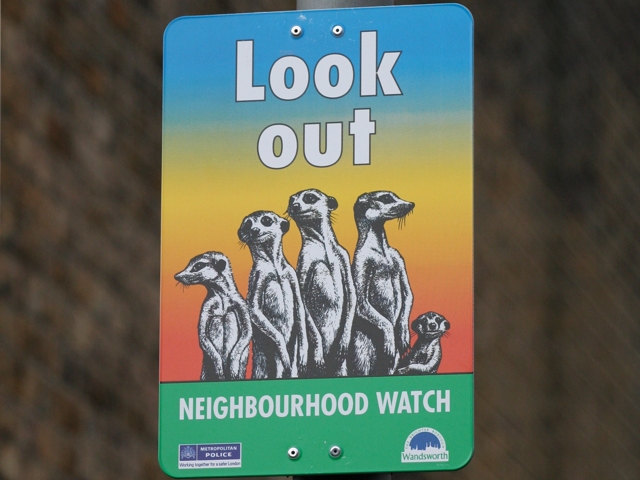
I used to be quite involved in Wandsworth Neighbourhood Watch in a strange, semi-detached, way as the cabinet member responsible for the council’s involvement in the scheme. Wandsworth Council is quite unusual in having taken on responsibility for running it from the police, and has traditionally had one of the strongest networks in the country. But that responsibility perhaps created meant focusing on the wood rather than the trees.
The council and police have recently highlighted a spate of burglaries in the ward, mainly in the roads between Lavender Hill and Clapham Common and while the police have done a lot to tackle that (fairly recently they made four arrests which combined accounted for a lot of the crime) they were also keen to see Neighbourhood Watches playing their part.
What struck me though, looking at a presentation they laid on, was how the north of the ward, the Shaftesbury Park Estate, had hardly any active Watches at all. I may have spent years being proud of the extensive Neighbourhood Watch network in Wandsworth, but had not noticed the decline on my front door.
It was a revelation for me. It’s been nearly three years since I had any responsibility, but even before, I’d never looked at the data mapped (which raises more thoughts on data visualisation that is for another time). Instead I’d focused on the overall number for the borough and the numbers per ward. Shaftesbury ward has always, and still does, fair well when compared to the rest of the borough and therefore never came to be a priority. Instead I focused on trying to innovate—by trying to create better networks and offering enhanced training—and work on those areas that were underrepresented—ward with high proportions of social housing have tended not to be involved.
The accepted wisdom has always been that there is a stronger sense of community in the Shaftesbury Park Estate and, therefore, an assumption that things like Neighbourhood Watch would thrive. This seems not to have been the case.
Naturally the lack of Neighbourhood Watch does not mean a lack of community, either on the Shaftesbury Park or elsewhere. It may well mean that community networks perform the same functions without the formal status. I do, however, think Neighbourhood Watch can act as a proxy measure for a sense of community, and while the correlation is not absolute there is a correlation.
I did wonder about how we could turn that around, but that is also something for another time: I have to practice what I preach, which means starting, or at least trying to start, a Watch in my own street, but as a council service and with the council elections imminent it raises all sorts of issues regarding purdah that make it inappropriate for me to do anything until June.
That does not, however, prevent others from starting, and if you are in Shaftesbury Ward I’m happy to offer whatever support I can (just get in touch). You can get further information from the council’s Community Safety pages and the national Our Watch website.
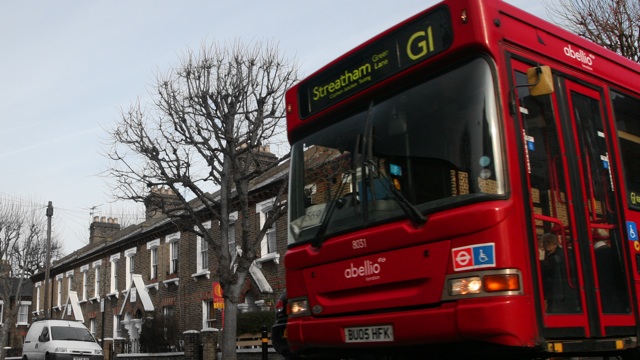
It was a hot night for a public meeting, and a hot public meeting to discuss the Transport for London (TfL) proposals to re-route the G1 bus route. Around 50 people attended and, for 90 minutes or so, had their say on the G1. I was surprised that the turnout exceeded that of the Shaftesbury Let’s Talk meeting earlier this year. Proof, perhaps, of the truth in Tip O’Neill‘s adage that all politics is local.
The background and suggestion are fairly simple. Residents on western part Sabine Road have suffered with the “stereo effect of the G1” travelling on the road in both directions, and have lobbied for a change ever since the current route has been in operation. These concerns were raised with TfL who suggested another option would be run the westbound route for the full length of Eversleigh Road.
The current situation is that around 120 people have replied to the TfL consultation, and the results are something like 65% against and 35% in favour: unsurprisingly there is an incredibly strong correlation between whether someone is for or against and whether they live on Sabine Road or Eversleigh Road.
Looking through the notes I jotted of the meeting I got the sense that the proportions last night were about the same, and again, largely a function of where the resident lived (I had some admiration for the Sabine Road residents who spoke up for a move; it is never easy to speak up in favour of something when a majority of those present have been vocally hostile towards it). Several additional points were raised, including a perception that the buses speeded through estate (although previous council traffic surveys didn’t find evidence of widespread speeding by any vehicle) and that something needed to be done on speed. Unfortunately enforcement of 20mph zones is not national police policy.
A few misconceptions were raised. Several seemed to think it was essentially a conspiracy by TfL because the introduction of Boris Bikes would require a new route. In fact, the two issues are separate and even if the bikes did need a new route—which they shouldn’t since they do not take road space, only parking spaces—it is invariably the case that Bernard Ingham’s version of Hanlon’s razor is correct.
Another misconception, which might be a matter of opinion, is that the council and TfL were wrong to even investigate this. Personally, whatever the outcome, I think we would have been wrong not to consider the complaints from, and issues faced by, the Sabine Road residents.
The consultation is still formally open and will probably be extended until 26 July so there is plenty of time for those who still want to comment. As I have said before, in technical terms I do not think there is much difference between the options, so it really is down to the consultation.
Unfortunately it is one of those topics in which it is not possible to end with a result that pleases everyone, since while there was widespread love for the bus service (any mention of the service’s value and wanting to keep it on the estate triggered applause), no-one really wants it going past their home. If there is an overall positive from this, it’s that the issue has resulted in the formation of the Shaftesbury Residents’ Group, and hopefully the energy they have displayed opposing this will go on to help with other issues and topics affected the Shaftesbury Park Estate.


Organised by the three ward councillors the meeting will be attended by officials from TfL and the council and will allow residents to express their views—for and against—the proposals. As I stated in my previous post, I suspect a great deal of weight will be given to public attitude since the technical arguments for either route are quite marginal.
The meeting is open, so you can just turn up, and will take place at 7pm on Tuesday, 9 July at Shaftesbury Park School on Ashbury Road.

I have a soft spot for the G1. It has always struck me as a cozy route and is probably the most friendly bus on which I have ever travelled in London. However, not everyone is a big fan of the route, so Transport for London are consulting on re-routing it for part of its journey through the Shaftesbury Park Estate.
In essence, the proposals would mean that on its journey southbound it would remain on Eversleigh Road, rather than travelling half-way along Eversleigh Road before turning up Grayshott Road and then along Sabine Road before leaving.
TfL made the proposal in response to complaints residents of Sabine Road made to the council about, among other things, speeding buses, damage to cars and traffic congestion caused by the buses.
To deal with the bread-and-butter of the issue first the formal consultation runs until 12 July, and a letter and map of the changes should have been sent to all households in the area. However, following the negative response from Eversleigh Road it looks like they will be extending that consultation period. As councillors we are trying to organise a public meeting on the issue in conjunction with TfL. If you would be affected, positively or negatively, by the proposed changes I encourage you to respond directly to TfL.
Less straightforward is how to satisfy everyone. Or, if you assume that not everyone can be satisfied, how you achieve the most satisfaction for residents.
The G1’s route was changed fairly recently. Until a few years ago its southbound journey took it on a dog-leg out of the estate via Eland Road. While that change was not universally popular I have no doubt that Eland Road was unsuitable for a bus, aside from being a fairly steep hill, there are no natural passing places and the entry onto Lavender Hill is narrow.
To my mind—which is only that of a mildly well-informed layman on traffic management matters—the arguments between Eversleigh and Sabine Roads are less clear. Indeed, they are so unclear that some of the arguments can be made both ways depending on viewpoint. One argument raised is that the change will mean some less mobile passengers will have further to go to catch the bus. The obvious counter argument is that some less mobile passengers will not have to go as far to catch the bus.
But cherry-picking that argument should not detract from some of the real concerns about the impact on traffic at the junction, the loss of parking spaces on the final corner and the impact of the bus on a road that already has significant noise issues from the railway line to the north.
At the risk of being overly philosophical (and as ever, I considered self-censoring, before deciding to publish and be damned) there is a utilitarian dimension to the issue. There is clearly dissatisfaction with the current route from Sabine Road residents. There is also dissatisfaction with the proposed change from Eversleigh Road residents. Given that no-one is suggesting removing the route from the estate and there isn’t a magical solution that pleases everyone (unless I lack the imagination to see it) which option creates the fewest problems and least unhappiness?
I’m happy to admit that, at this stage, I just don’t know. Indeed, this may be one of those issues where there is never enough concrete evidence to favour one option over another. I suspect that TfL are in a similar position, so whatever your views, I’d recommend making sure they know.
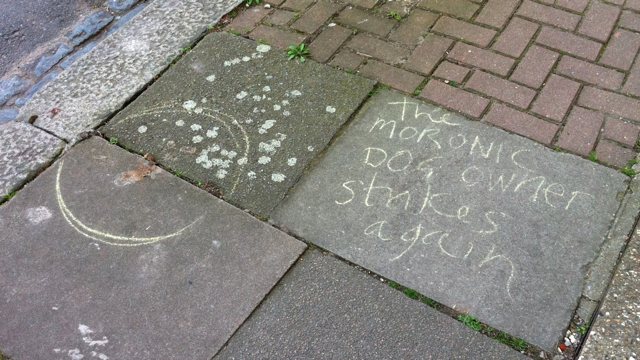
There’s something about being a councillor and dog poo.
You can’t just blame it on irresponsible and inconsiderate dog-owners and move, carefully, on. Instead, it provokes thought and even, dare I say, analysis. Being a councillor isn’t the only frame of reference for me – yesterday I couldn’t help but reflect I’d discovered the least-joyous part of fatherhood as I cleaned the push-chair wheels of the left-overs from a dog that was probably the size of a Shetland pony – but I can’t imagine any other reason I would be prompted to write a blog post from my reflections on dog excrement.
But as soon as spotted this on Forthbridge Road I was taking a photo and knew it would end up on here.
What is interesting is not so much the resident’s frustration (they should try the Shaftesbury Estate) but the effect it will have on the dog-owner. A council in the south of England tried colourfully marking the locations of dog-fouling. The result was a dramatic decrease in the level of dog-fouling; the markings created a feeling of guilt and fear of being watched among irresponsible dog-owners.
It’s Nudge at work. I’ve noticed a reverse effect around a tree near my house, it is a cherry blossom (I believe, but my arboricultural knowledge pretty much ends at differentiating trees from shrubs) attracts lots of birds which do a fantastic job at plastering the pavement underneath with their droppings. The result is a tree that attracts most of the road’s dog fouling too, it seems the bird droppings make other animal fouling more acceptable.
It’s a perennial problem. I often get complaints about it and noticed a report from the Shaftesbury Park Estate on Fix My Street last week. Unfortunately the real solution lies in dog owners acting responsibly and being able to find and prosecute those who do not. While approaches like that taken on Forthbridge Road might work (and I’m not so far beyond redemption that I’m monitoring it) by far the best answer is for all owners to clean up after their dogs.
[It’s taken me nearly 13 years to do my first dog poo photo. I just hope it isn’t a slippery slope because it doesn’t look good at the bottom.]
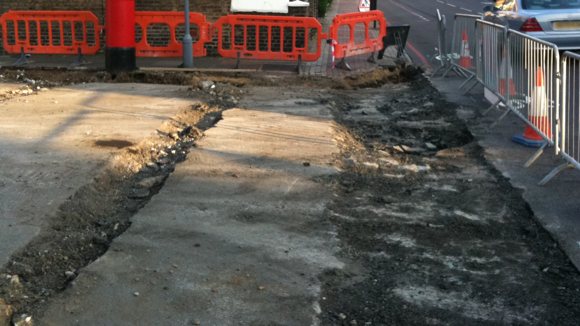 Transport for London have finally started working on the entry treatments to the Shaftesbury Park Estate that will make it a 20mph zone.
Transport for London have finally started working on the entry treatments to the Shaftesbury Park Estate that will make it a 20mph zone.
Local residents will know that equipment and stock from the works they did to the entries to Amies Street have sat on Sabine Road for some time. And Wandsworth Council have been placing 20mph signs up around the estate in preparation.
However, yesterday they closed Sabine Road at the junction with Latchmere Road and began work. Along with the cushions already in place within the Shaftesbury Park Estate area it is designed to improve safety and reduce speeding along the long straight roads of the estate.
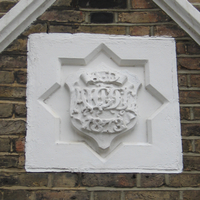 For some time my to do list has included ‘Write a Wikipedia article about the Shaftesbury Park Estate’. I’ll freely confess that it was never at the top of the list, and it was always one of those things I wanted to do one day when I had time. That day that never really comes.
For some time my to do list has included ‘Write a Wikipedia article about the Shaftesbury Park Estate’. I’ll freely confess that it was never at the top of the list, and it was always one of those things I wanted to do one day when I had time. That day that never really comes.
However, I noticed today that someone has finally got around to writing an article. Like anything on Wikipedia it is a work in progress, and seems to borrow heavily from the council’s own conservation area appraisal statement.
However, I can’t say how pleased I am that someone else had the same idea. While I know that Wikipedia has many faults, it remains a heavily used resource for many people. And it was always a matter of pride that while other places had their articles, Shaftesbury Park didn’t.
I’ve made a few, limited, changes as time allowed to the article. But do you know anything about the estate that should be added (or have you spotted something wrong that should be removed)? I think there’s a great history to the estate and we should make sure it’s told.
 I’ve posted about this a few times before, but investigated a little further when asked by a resident recently if it was still happening. They had not seen any of the works they expected taking place.
I’ve posted about this a few times before, but investigated a little further when asked by a resident recently if it was still happening. They had not seen any of the works they expected taking place.
I was also a little confused when Transport for London (TfL) started working on the other side of Latchmere Road. Part of me did wonder if they had made a mistake!
However, it is all going ahead as planned. If you wander down to Tyneham Road the preparatory work on the some of the junctions there has already taken place, with the junctions further in the estate next in line. In fact, the whole programme is going more or less to schedule, although the start was delayed slightly by the adverse weather.
The TfL works are down to them having decided to implement a cycling scheme. This will see the two junctions of Amies Street and Latchmere Road along with the junctions with the Poyntz Road triangle at Knowsley Road and Shellwood Road get entry treatments. The Heathwall Street and Sabine Road treatments will be completed as part of this work (and in the same style as the road cushions inside the estate).
Incidentally, while trying to find out about this I came across TfL’s roadworks map. It’s not the most accurate, it’s showing the us as the ‘owner’ of some works that are theirs and lists one of the schemes as cancelled, which it certainly hasn’t been. However, it’s a potentially useful resource – or just interesting if you are geeky like me.
Elsley School’s move to the Nightingale site looks like being made permanent. The site has been empty for some time now, and on occasion been a cause for concern and problem for neighbouring residents.
To be fair I’m not that surprised. I was chairman of governors at the school immediately before it ‘federated’ with Nightingale, the school that was effectively its big brother. At the time the school had a number of problems (some of which I was there to try and address) but one of the biggest was the sheer inadequacy of the building as a modern school – problems compounded by it being a special school.
And a Victorian school building often isn’t that suitable for anything anymore. It’s hard to imagine how the spaces within can be productively used for anything. The council will be demolishing the remaining buildings on the site (the Pupil Referral Unit was demolished some months ago) which will also enhance the overall security of the area for local residents and the site declared surplus to requirements.
In a way it’s sad, since the building clearly has history – there are some fascinating old photos of the school from Victorian times – but putting emotion to one side and looking at the site rationally it is, sadly, no longer a viable site for education and in its current state of no use to the wider council.